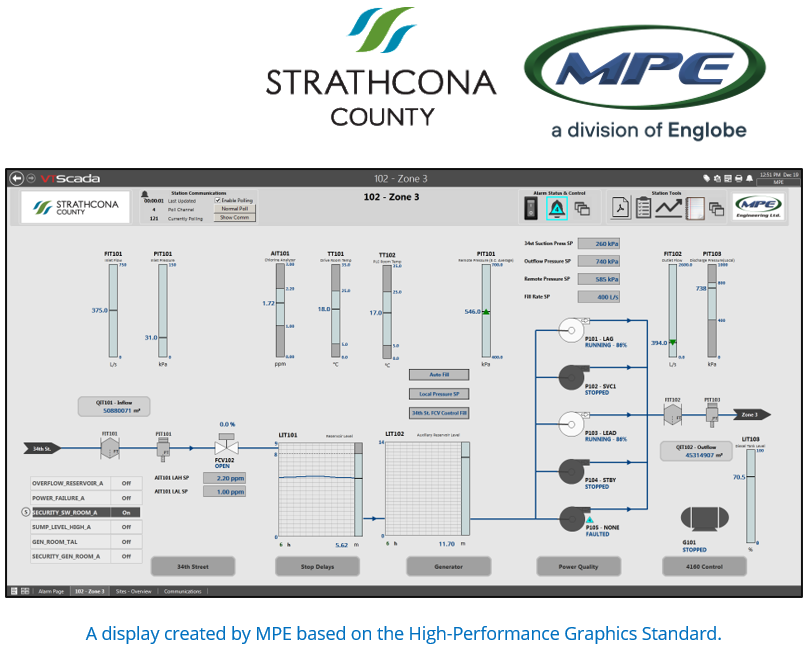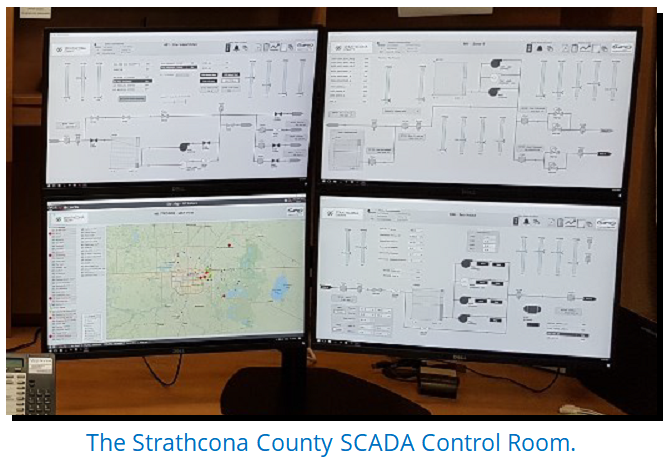A Profile of Strathcona County, AB

Strathcona County is comprised of several thriving communities totaling over 98,000 residents within the Edmonton Metropolitan Area. The Utilities Department is responsible for the operations and maintenance of the water and wastewater systems located within Sherwood Park and in various rural hamlets throughout the County. In 2016, the County decided to replace their aging SCADA software system that was no longer supported by the vendor. Inconsistent tag naming made it frustrating to develop and the lack of continuity in the displays made it confusing to operate. Access to historical data was time consuming and remote access was limited. Most critically, the system had no backup should its single server fail. The Utility selected MPE, a division of Englobe to design and deploy a new SCADA application which complies with industry standards such as High Performance Graphics and the ISA 18.2 Alarms. Zane Spencer, Project Manager and Controls Programmer with MPE, describes the completed system that they created using VTScada software from Trihedral.
SCADA Architecture – “VTScada now monitors 53 remote sites consisting of the water pump house, water pressure reducing valves (PRVs), lift stations, and wastewater lagoons,” says Spencer. VTScada uses an integrated driver library to directly communicate with the Utility’s monitoring and control hardware which includes GE 90-30 PLCs, GE-Rx3i PLCs, Siemens S7-1200 PLCs, and SCADAPack RTUs.
The MPE team configured three networked SCADA servers to provide redundancy and flexible workstation access. Since VTScada’s architecture is integrated, each of these servers contains a complete copy of all historical and configuration data synchronized up to the second.
The new servers improve system access both in the office and in the field. “There is now a dedicated engineering workstation with a four-monitor setup and two operator workstations, one quad monitor and one dual monitor,” describes Spencer. “A replicated workstation in a DMZ allows remote third-party access to VTScada historical data from a non-production machine. A fourth operator workstation was configured on an internet facing network and allows operators to access VTScada or other SCADA systems over the internet.” VTScada’s integrated Thin Clients allow operators to remotely access their process via mobile devices such as tablets and smart phones.
Consistent Tag Design – “Tags were standardized using ISA 5.1 naming conventions,” says Spencer. “The old system used Modbus addresses for all tag names and had no descriptions in the tags. The client provided an extensive list of tag names and descriptors. We managed the creation of tags using VTScada Context Tags. These parent tags represent devices with multiple child tags representing device attributes such as statuses, values, and alarms.”
High Performance Graphics – “All graphics were designed based on ISA High Performance Graphics Standards, which is what we are most proud of.” This design methodology uses simple greyscale graphics to represent a system operating normally. Color begins to emerge as values approach tolerances or alarms are tripped. This approach allows operators to instantly see emerging problems. VTScada’s extensive library of grey scale images and symbols can change color and appearance based on tag values. “High Performance Graphics were client driven, which was nice because we did not have to sell this to the operators, the client took care of that,” says Spencer. “Operators did not love the greyscale graphics at first, but once the benefits and added contextual information was explained to them, they warmed to the idea and now, after a few months, truly enjoy the benefits associated with the new graphics.”
ISA 18.2 Alarming – The ISA 18.2 Alarm Management Standard helps utilities to develop a consistent approach to alarm creation and acknowledgement. It also helps to reduce nuisance alarms which can obscure real issues. VTScada’s integrated Alarms Manager uses color, symbols, and sound to allow operators to easily scan the alarm list and see the status and priority of each alarm. Built-in reports help to identify ‘Bad Actor’ alarms, trace ‘alarm floods’, and audit alarm priority distribution per ISA’s recommendations. During scheduled hardware maintenance, staff can temporarily ‘shelve’ associated alarms to avoid distractions.
Reporting – MPE used the native report generator to create the following reports which are all grouped by type and station:
- Totalized flows from flow totalizers.
- Daily runtime of all monitored hour meters.
- Minimum, maximum, and average chlorine levels.
- Water pressure.
- Motor amperages.
- Reservoir levels.
- Totalized water consumption flows for Regional Water Customers Group.
Reports automatically run each day at midnight for the previous day. The system can automatically email reports to the appropriate people or send them to a printer. They can also encompass the daily reports into monthly and/or yearly reports. Staff can create custom reports based on tags, timeframe, date, or other criteria. “The VTScada reporting system works directly with our standard Excel reporting templates, which only required slight modification, eliminating the need for third-party middleware software” says Spencer.
Remote ‘Thin Client’ Access – “Now, multiple operators, managers, and engineers have secure remote access using mobile phones and tablets. Using the VTScada Anywhere Client, paired with the unlimited Thin Client licenses there are no concerns about users fighting for control of the system.” The Anywhere Client provides a consistent operator experience using any HTML5 compliant browser.
Distributed Local Historians – The County was also concerned about the potential loss of data should the connection to remote sites be lost. In response, MPE configured the application to allow for use of VTScada as local HMIs at all remote stations. Once VTScada is deployed as a local HMI, if the station is cut off from the central application, the local HMI continues to provide local monitoring and control while collecting alarm and historical data. When communications to the local site are restored, all local alarm and historical data is backfilled into the central SCADA system. This was completed for one of the major pump houses during this project. To implement this solution, MPE supplied and installed a local panel mount PC, replacing an existing HMI at the local station. “It’s running the same VTScada application as the centralized servers but using tag and alarm area filtering to reduce the license cost and present only relevant information to local operators,” says Spencer. “Using VTScada as an HMI replacement, and structuring the tag database appropriately, we have effectively implemented historical store-and-forward allowing the County to eliminate data loss when communication links to the station are disrupted. An added benefit is the synchronization with the central system; all graphics, user accounts, alarm history, and alarm configurations are synchronized in real-time. The SCADA application is pre-structured to allow for this configuration at all remote sites and the County would like to implement VTScada as a local HMI for all stations in the future.”
Installation – “The replacement system was designed and tested in parallel to the existing system to eliminate system downtime,” says Spencer. “The project was completed under-budget with no disruption to operations or significant system failures during the switchover. As with anything, there were some glitches to work through during the testing and commissioning phases. However, due to the template-based tag database, large scale changes could be rapidly deployed and tested with minimal system impact.”
Conclusion – Spencer has this advice to utilities looking for SCADA solutions, “Do your research first, attend training if possible for multiple platforms, and select the one that you would like to work with for the next 20 years. Talk to sales personnel but also talk to the management teams and tech support teams to get a sense of the support that you will receive after the initial purchase. Also, be specific when preparing RFP documents and select qualified consultants who have proven experience with the preferred software solution.”
The MPE technical staff has attended both basic and advanced training. They continue to choose VTScada because of its ease-of-use and transparent licensing costs. Spencer comments, “VTScada has helped MPE increase efficiency on our projects by allowing us to develop standards and templates that are easily re-used from project to project and allows us to rapidly develop high quality, high functionality SCADA systems. We are proud of the innovative features we add to every system we create and are excited by the seemingly endless possibilities for innovation with the VTScada product.”
About MPE, a division of Englobe – MPE is a medium-sized, multidisciplinary consulting engineering firm servicing Western Canada through seven regional offices. We offer services in municipal and urban development, transportation engineering, water/wastewater treatment, water resources, electrical, controls & automation, SCADA and building services. Formed in 1983, the company has steadily grown to over 200 personnel. www.mpe.ca
| Try It For Yourself Download the 90-day Trial | For More Details: Zane Spencer, 1-866-329-3442 zspencer@mpe.ca |

